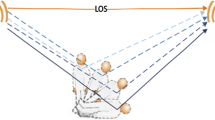Abstract
Virtual fingerprints have been proposed in the context of WiFi Fingerprinting Indoor Positioning systems in order to reduce the effort dedicated to offline measurements. In this work, the use of Multi-Wall Multi-Floor indoor propagation models to generate such virtual fingerprints is investigated. A strategy taking into account the impact of user/device orientation on the signal propagation is proposed, leading to the creation of virtual and oriented fingerprints. The work analyzes then the trade-offs between model accuracy and measurement efforts by means of experimental results, showing that good modeling accuracy can be guaranteed while significantly reducing the complexity of the offline measurement phase.







Similar content being viewed by others
References
Liu H, Darabi H, Banerjee P, Liu J (2007) Survey of wireless indoor positioning techniques and systems. IEEE Trans Syst Man Cybern C Appl Rev 37(6):1067–1080
Honkavirta V, Perälä T, Ali-Löytty S, Piché R (2009) Comparative survey of WLAN location fingerprinting methods. In: Workshop on positioning, navigation and communication. IEEE Press, New York, pp 243–251
Bahl P, Padmanabhan VN (2000) RADAR: An In-building RF-based user location and tracking system. In: IEEE International conference on computer communications, pp. 775–784 (2). IEEE Press, New York
Kessel M, Werner M (2011) SMARTPOS: Accurate And precise indoor positioning on mobile phones. In: International conference on mobile services, resources, and users. IARIA XPS Press, pp 158–163
Liao I-E, Kao K-F (2008) Enhancing the accuracy of WLAN-based location determination systems using predicted orientation information. Inform Science 178(4):1049–1068
Hossain A. KMM, Van HN, Jin Y, Soh W-S (2007) Indoor localization using multiple wireless technologies. In: IEEE International conference on mobile adhoc and sensor systems. IEEE Press, New York, pp 1–8
Widyawan, Klepal M, Pesch D (2007) Influence of Predicted and Measured Fingerprint on the Accuracy of RSSI-based Indoor Location Systems. In: Workshop on positioning, navigation, and communication. IEEE Press, New York, pp 145–151
Chintalapudi K, Iyer AP, Padmanabhan VN (2010) Indoor localization without the pain. In: International conference on mobile computing and networking. ACM Press, New York, pp 173–184
Eleryan A, Elsabagh M, Youssef M (2011) Synthetic generation of radio maps for device-free passive localization. In: IEEE Global communications conference. IEEE Press, New York, pp 1–5
COST Action 231 (1999) Digital mobile radio towards future generation systems. Technical report, European Commission
Borrelli A, Monti C, Vari M, Mazzenga F (2004) Channel models for IEEE 802.11b indoor system design. In: IEEE International conference on communications. IEEE Press, New York, pp 3701–3705
Small J, Smailagic A, Siewiorek DP (2000) Determining User Location For Context Aware Computing Through the Use of a Wireless LAN Infrastructure. [Online at] http://www-2.cs.cmu.edu/aura/docdir/small00.pdf
Youssef M, Agrawala A, Udaya Shankar A (2003) WLAN Location determination via clustering and probability distributions. In: IEEE International conference on pervasive computing and communications. IEEE Press, New York, pp 143–151
Roos TT, Myllymäki P, Tirri H, Misikangas P, Sievänen J (2002) A Probabilistic Approach to WLAN User Location Estimation. Int J Wireless Inform Network 9(3):155–164
Ladd AM, Bekris KE, Rudys A, Kavraki LE, Wallach DS (2005) Robotics-based location sensing using wireless ethernet. Wirel Netw 11(1-2):189–204
Kaemarungsi K, Krishnamurthy P (2004) Properties of indoor received signal strength for WLAN location fingerprinting. In: IEEE International conference on mobile and ubiquitous systems: Networking and services. IEEE Press, New York, pp 14– 23
Li B, Kam J, Lui J, Dempster AG (2007) Use of directional information in wireless LAN based indoor positioning. In: Symposium on GPS/GNSS (IGNSS)
Liu H, Yang J, Sidhom S, Wang Y, Chen Y, Ye F (2014) Accurate WiFi Based Localization for Smartphones Using Peer Assistance. IEEE Trans Mobile Comput 13(10):2199–2214
Jekabsons G, Zuravlyov V (2010) Refining Wi-Fi based indoor positioning. In: International scientific conference applied information and communication technologies, pp 87–95
Feng C, Au WSA, Valaee S, Tan Z (2012) Received-Signal-Strength-Based Indoor positioning using compressive sensing. IEEE Trans Mobile Comput 11(12):1983–1993
Author information
Authors and Affiliations
Corresponding author
Additional information
A preliminary version of the present work appeared in Caso, G., De Nardis, L.: On the Applicability of Multi-Wall Multi-Floor Propagation Models to WiFi Fingerprinting Indoor Positioning . In: International Conference on Future Access Enablers for Ubiquitous and Intelligent Infrastructures, LNICST Vol.159, Springer, Berlin (2015).
Rights and permissions
About this article
Cite this article
Caso, G., De Nardis, L. Virtual and Oriented WiFi Fingerprinting Indoor Positioning based on Multi-Wall Multi-Floor Propagation Models. Mobile Netw Appl 22, 825–833 (2017). https://doi.org/10.1007/s11036-016-0749-x
Published:
Issue Date:
DOI: https://doi.org/10.1007/s11036-016-0749-x




